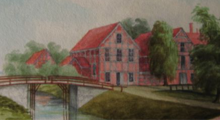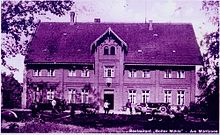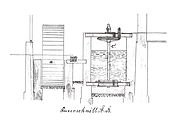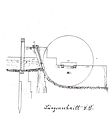Bolter mill
| Bolter mill
|
||
|---|---|---|
| Location and history | ||
|
|
||
| Coordinates | 53 ° 22 '15 " N , 12 ° 46' 45" E | |
| Location | Mecklenburg-Western Pomerania , Mecklenburg Lake District , Rechlin | |
| Waters | Bolter Canal , Müritz-Havel waterway | |
| Built | 1665, remodeled in 1890 | |
| Shut down | 1910 | |
| Status | Reconstruction and conversion | |
| technology | ||
| use | Grain, gypsum, sawmill | |
| drive | Watermill | |
| water wheel | Zuppinger Niedergehällerad, undershot | |
| Website | http://www.boltermuehle.de/ | |
The Bolter Mill is a former water mill . It is located in Mecklenburg-Western Pomerania on the southeastern bank of the Müritz on today's Bolter Canal . It is one of the oldest secular buildings in the southern Müritz region. Of the former mills, the listed two-storey main building with the southern decorative gable in the red brick typical of the region and the gear house from a renovation from 1890 have been preserved. The water wheel systems of the Bolter mill and the inlet from the Bolter Canal were largely repaired by the municipality of Rechlin between 2013 and 2015. The water wheel has been operated as a show wheel by the municipality since August 2015.
geography
The Bolter Mill is located in the south of Mecklenburg-Western Pomerania in the Mecklenburg Lake District in the Rechlin municipality . It is located at the former Bolter lock, the crossing point of various tourist water, hiking and cycling routes:
- Bolter Canal with the Alte Fahrt water route - the connection between Müritz and Woterfitzsee
- Long -distance cycle routes: Mecklenburg Lake Cycle Route and international cycle route Berlin – Copenhagen (4 km away)
- Müritz circular route
- Müritz National Park Route Rechlin-Boek
- Müritzsteilufer hiking trail
The Müritz National Park is located northeast of the Bolter Mühle . Southwest of the Bolter Mühle is the nature reserve Müritzsteilufer near Rechlin.
In 1665, with the construction of the old Bolter moat, a first water connection was created between Müritz and Carpsee and thus to Woterfitzsee and the Havel waters . In 1832 this connection became navigable through the expansion to the Bolter Canal and the construction of the Bolter Lock. This made the Müritz a watershed between the Elde / Elbe in the north and the Havel / Spree in the south.
history
The Bolter Mühle owes its economic and political importance to its location on the Bolter Canal and thus on the watershed between the Elde / Elbe in the north in the state of Mecklenburg-Schwerin and the Havel / Spree in the south in the state of Prussia . At the Bolter mill it was possible to control the water drainage and water levels in Mecklenburg on the one hand and in Prussia on the other.
The Bolter Mühle was founded in 1665, almost 400 years after the neighboring Boeker Mühle, by the Order of St. John Mirow.
In the first 1¼ centuries it was contested because it used too little water, later because it used too much water. The complaints of the Mecklenburg government were directed against the high consumption due to the lowering of the Müritz level, which led to a lack of water in the Eldemühlen located above the Müritz. Too little water withdrawal led to a water shortage along the Havel and complaints from the Prussian government.
The Bolter mill belonged to the Retzow estate and had been owned by the Hammerstein-Gesmold von Retzow family since the end of the 18th century . The location of the watermill northeast of Klopzow is shown on the Schmettauschen map from 1780.
At the end of the 18th century, the Bolter Mühle was again the focus of political interests when the states of Prussia, Mecklenburg-Schwerin and Mecklenburg-Strelitz envisaged improving both Elde and Havel shipping. On the one hand, the shipping itself should take place via Bolter Mühle from the Müritz to the Havel, on the other hand, the Havel water level should generally be increased.
A convention between Mecklenburg-Schwerin and Prussia of 1789, which was followed by an agreement with Mecklenburg-Strelitz to join this convention in 1799, assumed that water extraction from the Müritz would be beneficial for both the Havel and Eldeschiffahrt. The water withdrawal at the Bolter mill was set at 0.93 m 3 / s, that of the Boeker mill at 0.76 m 3 / s and the right of Prussia to these amounts of water was contractually agreed. With this increase in importance of the mill as an object of political agreements, the decline of its actual function began.
After the Boeker Mühle ceased to exist around 1825 and the water supply to the Havel via Boek dried up, the Bolter Mühle was the only way to feed Müritz water into the Havel area. In 1834 a weir was built directly in front of the mill to secure the water above the Müritz, which is necessary for shipping and for the Plauer mill.
An extensive renovation of the mills planned around 1850 at the instigation of the Prussian government was prevented by the Mecklenburg-Schwerin Ministry of the Interior, as adverse consequences for Mecklenburg-Schwerin due to a lowering of the Müritz water level, reduced runoff to the Elde and water shortage for the mills and the Shipping on the Elde were feared. Contrary to the assumption in the Convention of 1789, it turned out that the water abstraction for the Havel had a negative effect on Eldeschiffahrt. On February 9, 1887, the provisions of 1798 were replaced by a state treaty with Prussia. The State Treaty finally stipulated that a maximum of 0.93 m 3 / s may be taken from the Müritz to the Havel and this exclusively at the Bolter Mühle.
In 1890/91, the then owner Ludwig Friedrich Ernst Freiherr von Hammerstein Gesmold on Retzow undertook a comprehensive renovation of the Bolter mill. After the renovation, the Bolter Mill had three channels: saw, mill and freer channels, which together could drain a much larger amount of water than allowed. Eel fishing was part of the grinding mill. The Mühlbach branched off above the sluice and flowed back into the canal below.
The mill was in operation until 1910. The last mill leaseholder, Stangenberg, moved to Kiel in 1911. The reason given for this is the remote traffic situation of the Bolter mill. In 1911, the landlord Otto Strümpfler from Klopzow acquired the Bolter mill from Baron von Hammerstein-Retzow on the Klopzower Feldmark by means of a long lease. In the same year, Strümpfler declared himself ready to transfer all rights and obligations that he had acquired through his long-term lease to the company Berlin-Mecklenburgische Dampfschiffahrt Zeitz and Weidemann (Heinrich Zeitz from Berlin and businessman Weidemann from Fürstenberg ). Should the sale to this company (straw men of the Prussian government) not take place, Strümpfler wanted to sell the mill to the Prussian tax authorities. If Strümpfler resigned from these contracts in the interests of Mecklenburg, he expected the mill to be bought by the Schwerin government or the river engineering commission.
In 1913, after extensive negotiations, from which it emerges that the Schwerin government was only concerned with preventing the acquisition of the mill and the associated water rights by Prussia, the State Parliament approved the Highest Grand Ducal Mecklenburg-Schwerin Rescript for the purchase of the Bolter mill . After the mill had passed into the possession of the Mecklenburg-Schwerin government for 42,000 marks in 1914, the old mill works and machines were removed and the turbine runs closed. The existing machines and equipment were sold to the factory owner B. Bentzin in Neustrelitz for 850 marks.
The Bolter Mill, as it can be seen today, is the last and smallest of what used to be three large mill buildings. It is the miller's former home. In 1919 part of the mill building and part of the land were leased by Gut Retzow. In 1928 the buildings belonging to the state of Mecklenburg were demolished. The part belonging to Gut Retzow was leased (tenant Karl Lambeck) and used as an inn.
From 1920 the southeastern Müritz region became of increased military interest. The publicly manned Bolter Canal and the publicly operated Bolter Lock were an obstacle for the expansion of the test site of the German Air Force in Rechlin , which was officially promoted from 1933 onwards . To replace the Bolter Canal, a new canal was built in the south of the Müritz. In 1936, when the new Mirow-Lärz Canal went into operation, the Bolter Canal was closed to public use. In 1956, with the final closure of the Bolter Canal and the filling of the Bolter lock, the Mühlenbach at the Bolter Mühle was also closed. In the 1970s, the Bolter mill again lost part of its property, this time to the local fishing cooperative for the construction of a round tank system for fish farming. Benefiting from the available water capacity and the natural water gradient, numerous fish ponds were created around the Bolter mill, which are still in operation today.
Hydroelectric power plants from 1890
After the last renovation in 1890/91, the Bolter mill had three channels : saw, mill and freer channels . The turbines were driven by an undershot Zuppinger water wheel. With a flow rate of approx. 1 m 3 / s and a head of 2.8 m, the mill generated an output of 30 HP.
- Construction drawings of the water wheel and turbine systems of the Bolter mill after the last major renovation in 1890
reconstruction
In 2010, the reconstruction of the Bolter Mill began.
The main building, which had been badly damaged by decades of vacancy, was renovated in accordance with the preservation of historical monuments, and the former gear house and the former warehouse building with two basement floors were repaired.
- The statics in the main house were reinforced by extensive steel structures.
- Half-timbered and wooden beam constructions were renovated.
- 111 windows were newly installed or refurbished in the main building alone,
- 40 window sills renovated,
- 4600 facade stones refurbished or renewed,
- 720 m 2 roof area covered with old church beaver tails, gained through demolition, and new ones.
- A large part of the beam heads, the structural static elements and the facade could be preserved.
The new water wheel
With the renovation of the Mühlenbach, which took place from 2014 to 2015, one of the Bolter Mill's water wheels was rebuilt based on the historical model. The new water wheel of the Bolter mill was put into operation on August 15, 2015. Planning and implementation were carried out by the municipality of Rechlin as part of the project for the renewal of the Bolter Canal boat transfer point. The Bolter Mühle has assigned the water rights for the water withdrawal of 100 l / s to the municipality.
- Data
- Diameter: 4.20 meters
- Width: 1.20 meters
- Shovels: 36
- Type: undershot waterwheel, drive from below (opposite: Ober- or Mittelschlächtiges waterwheel)
- Water flow rate: maximum 100 l / s; an average of 30–40 l / s, regulated by the Müritz water level at an overflow weir at the Mühlenbach inlet
- Material: Corten steel (weatherproof structural steel, forms a thin layer of rust on the surface, the steel layers below are protected against further corrosion)
- Water level difference between Müritz and Bolter Canal: 2.70 - 2.80 m (depending on the water level)
- Energetic use: currently none (1890: 30 HP)
Todays use
The Bolter Mühle has been used as a special kind of holiday accommodation and event location since 2013. There is a small park and a small herb garden on the premises. Concerts and readings take place in the summer months. In addition to changing exhibitions by regional artists, the Bolter Mühle also houses a permanent exhibition by Röbel painter Inge Wolf. The Bolter Mill is also the seat of the company minna-server (automation and software development).
literature
- Gerhild Meßner: History of the Müritz National Park Region . Ed .: Förderverein Müritz-Nationalparkverein eV 1st edition. Wegwarte Foto- und Gestaltung, Speck 2009, ISBN 978-3-00-030592-4 .
Web links
- Literature about Bolter mill in the state bibliography MV
- Official website of the Hotel Bolter Mühle
- Old trip - water hiking route
Individual evidence
- ↑ History of the Bolter Mill . www.bolterschleuse.de, Reconstruction and History of the Bolter Mill, accessed on April 5, 2014.
- ↑ History of the Bolter Mill . www.bolterschleuse.de, Reconstruction and history of the Bolter Mühle, created by Jürgen Kniesz, accessed on April 5, 2014.
- ↑ Südliche Müritzregion aktuell, SMR, March 2014 edition, publisher and editor: municipality Rechlin.











